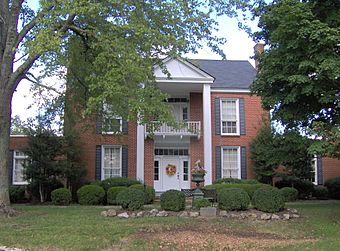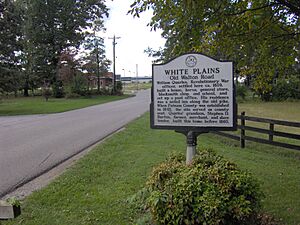White Plains (Cookeville, Tennessee) facts for kids
Quick facts for kids |
|
|
White Plains
|
|
 |
|
| Location | 2700 Old Walton Road |
|---|---|
| Nearest city | Cookeville, Tennessee |
| Area | 15 acres (6.1 ha) |
| Built | circa 1848 |
| NRHP reference No. | 09000538 |
| Added to NRHP | August 11, 2009 |
White Plains is a historic house located near Cookeville, Tennessee. It was built before the American Civil War and served as an important stop for travelers in the 1800s. In 1854, it even became the temporary county seat for Putnam County, Tennessee. Today, White Plains is recognized for its history and was added to the National Register of Historic Places in 2009.
The White Plains property was started in 1809 by William Quarles (1752–1814). He was a veteran of the American Revolutionary War who moved to the area from Virginia. His grandson, Stephan Decatur Burton (1813–1892), built the main house around 1848. Later, in the late 1950s, Harvey Draper bought the house and made many updates to it.
Exploring White Plains' Location
White Plains is found on the eastern Highland Rim. This is a flat, raised area between the higher Cumberland Plateau to the east and the lower Nashville Basin to the west. Mountains like "Algood Mountain" and "Buck Mountain" are about a mile to the east. The house is located on Old Walton Road, just outside the town of Algood, Tennessee.
A Journey Through Time at White Plains
The land where White Plains stands was once part of Cherokee territory. It became part of the United States after the Third Treaty of Tellico was signed in 1805. The Walton Road, a stagecoach route finished in 1801, brought the first settlers to this part of Tennessee. This road connected Knoxville and Nashville.
Around 1804, a pioneer named Daniel Alexander opened an inn along the Walton Road at what is now White Plains. In 1808, William Quarles, a lawyer and Revolutionary War veteran, bought the inn and land. He moved his family and belongings to the new property in December 1809. Family stories say Quarles named the land "White Plains" because the tall prairie grass looked white in the winter sunlight.
Soon after arriving, Quarles built a two-story log house. It had a separate kitchen and office, plus cabins for enslaved people. Within a few years, Quarles had also opened a general store, a blacksmith shop, and a post office at White Plains. Another important path, the Kentucky Stock Road, was later developed. It connected Huntsville, Alabama and Danville, Kentucky and crossed the Walton Road at White Plains.
The Quarles' inn was a very popular stop for travelers on these two roads. Three U.S. presidents— Andrew Jackson, James K. Polk, and Andrew Johnson— are known to have stayed there. William Quarles's youngest son, John Adams Quarles (1802–1876), might have even inspired author Mark Twain's famous story, "The Jumping Frog of Calaveras County." This is because John Quarles was married to Twain's aunt, Martha Lampton. Quarles's daughter, Sallie, was married to U.S. Congressman Adam Huntsman. He was known for defeating Davy Crockett in an election in 1834.
On April 2, 1814, William P. Quarles died. His wife, Ann Hawes Quarles, continued to manage White Plains until she passed away in 1844. The property then went to Stephen Decatur Burton (1813–1892), who was William and Ann's grandson. Burton built the current house at White Plains in 1848. He also built a two-story schoolhouse for the children in the small community.
During the American Civil War, Burton lost a large part of his wealth. This happened when Union forces burned warehouses in Chattanooga. Burton had stored a lot of cotton there.
After the 1800s, the community around White Plains became smaller. However, the house and farm stayed with the Quarles-Burton family for a long time. The family eventually sold the house to Harvey Draper, who updated it in the late 1950s. In 2018, the City of Algood bought White Plains. They plan to turn it into a museum for everyone to visit and learn from.
The House and Other Buildings
The main house at White Plains was built in 1848 by Stephen Decatur Burton. It replaced an earlier log house that had burned down. The original house had a strong log frame covered with wooden siding. It had a central hallway with two 15-foot by 15-foot rooms on each side on the first floor. The second floor also had four 15-foot by 15-foot rooms. A sitting room was added to the back of the house in 1925. In 1958, the house got a brick outside, a front porch, and two new single-story sections with a kitchen and more bedrooms.
Inside, the house originally had floors made of poplar wood. The first-floor poplar floor was covered with hardwood in 1958. Each of the original rooms had a fireplace with a unique mantelpiece. A special "dog-leg" staircase leads to the second floor. The hallway on the first floor has built-in gun cabinets and a large mirror from the 1800s.
Other buildings at White Plains include a smokehouse, a corn crib, and a horse barn. The smokehouse, built around 1860, was made of logs. It was updated into a log cabin in 1990. The corn crib, also a log building from around 1860, was moved from its original spot around 1950. It is now partly collapsed next to the smokehouse. The horse barn is a newer building, built around 2000, with wooden walls and a metal roof. The cemeteries for the Quarles and Burton families are located a short distance from the house.






